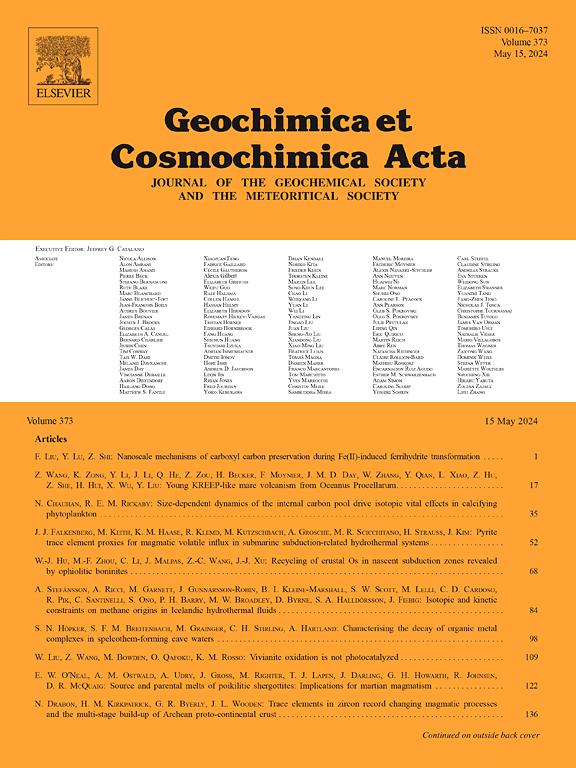Multiple fluid-rock interactions in the subduction channel evidenced by magnesium isotopes
IF 5
1区 地球科学
Q1 GEOCHEMISTRY & GEOPHYSICS
引用次数: 0
Abstract
Fluids from the subducted oceanic slab are closely associated with mass transfer in subduction zones, which significantly affect the composition of arc magmas and deep mantle. Previous studies have shown that magnesium isotopes can be used to identify the source of fluids and to trace carbonate cycling. However, the Mg isotope variation as a function of fluids in the subduction channel remains obscure. As large-scale fluid flows and strong fluid-rock interactions can significantly enhance elemental mobility, Mg isotope variations may be recorded in metabasaltic rocks with large-scale veins (which represent original fluid pathways). Here we present Mg isotope data for different parts of a metabasaltic block from Tianshan (ultra)high pressure metamorphic belt, southwest of China to reveal the Mg isotope composition of fluids and their effects in the subduction channel. All the samples have been divided into three groups depending on their position in each “pillow” of the metamorphic block, i.e., those from the omphacite-rich interior, glaucophane-rich vein and transitional part. The omphacite-rich interior is mainly composed of omphacite and phengite, with minor garnet, while the glaucophane-rich vein mainly consists of garnet, glaucophane and epidote. The transitional part between the omphacite-rich interior and glaucophane-rich vein is dominated by epidote and carbonate, and aragonite has been widely replaced by dolomite. Together with our previous study, we think that the metabasaltic block has experienced two stages of rehydration overprinting after eclogitization: the first stage rehydration led to the common enrichment of LILEs in the whole block compared to its protolith E-MORB; the second stage rehydration resulted in the carbonate reprecipitation at the transitional part and the redistribution of garnet component.
The δ26Mg values of the omphacite-rich interior are lower (−0.42 ‰ to −0.34 ‰) than those of MORBs (−0.25 ± 0.06 ‰), which probably indicates that subduction dehydration can lead to lighter Mg isotope composition of the residual eclogite and heavier Mg isotope composition of the released fluids. Furthermore, the lighter Mg isotope composition of the transitional part (δ26Mg = −0.67 ‰ ∼ −0.63 ‰) and glaucophane-rich vein (δ26Mg = −0.71 ‰ ∼ −0.54 ‰) may be caused by the reprecipitation of dolomite and garnet through Ca-Mg exchange as the result of interaction with externally derived carbonate rich fluids. The residual fluid after the reprecipitation of carbonate minerals is also expected to show a heavier Mg isotope composition. In addition, the recrystallization of dolomite in the subduction channel could not only hamper the influence of subducted carbonate-derived fluids on the heavier Mg isotope composition of arc magmas compared to MORBs, but also facilitate the transfer of carbonate with lighter Mg isotope compositions into the deep mantle.
镁同位素证明了俯冲通道中多种流体-岩石相互作用
俯冲洋板的流体与俯冲带的质量传递密切相关,对弧岩浆和深部地幔的组成有重要影响。以前的研究表明,镁同位素可以用来确定流体的来源和追踪碳酸盐循环。然而,Mg同位素的变化作为俯冲通道中流体的函数仍然不清楚。由于大规模的流体流动和强烈的流体-岩石相互作用可以显著增强元素的流动性,因此在具有大规模脉状(代表原始流体路径)的变质玄武岩中可能记录到Mg同位素的变化。本文通过对中国西南天山(超)高压变质带变质岩块体不同部位的Mg同位素数据分析,揭示了其流体的Mg同位素组成及其在俯冲通道中的作用。所有样品根据其在变质块体各“枕”中的位置分为三组,即富辉石质内部、富绿帘石脉和过渡部分。富辉石内部主要由辉石、云母组成,少量石榴石;富蓝铜矿脉主要由石榴石、蓝铜矿和绿帘石组成。富红辉石内部与富蓝铜矿脉间的过渡部分以绿帘石和碳酸盐为主,文石已被白云石广泛取代。结合我们之前的研究,我们认为变质岩块体在榴辉化后经历了两个复水化套印阶段:第一个复水化阶段导致整个块体的LILEs相对于原岩E-MORB普遍富集;第二阶段复水化导致过渡部分碳酸盐再沉淀,石榴石组分重新分布。
本文章由计算机程序翻译,如有差异,请以英文原文为准。
求助全文
约1分钟内获得全文
求助全文
来源期刊

Geochimica et Cosmochimica Acta
地学-地球化学与地球物理
CiteScore
9.60
自引率
14.00%
发文量
437
审稿时长
6 months
期刊介绍:
Geochimica et Cosmochimica Acta publishes research papers in a wide range of subjects in terrestrial geochemistry, meteoritics, and planetary geochemistry. The scope of the journal includes:
1). Physical chemistry of gases, aqueous solutions, glasses, and crystalline solids
2). Igneous and metamorphic petrology
3). Chemical processes in the atmosphere, hydrosphere, biosphere, and lithosphere of the Earth
4). Organic geochemistry
5). Isotope geochemistry
6). Meteoritics and meteorite impacts
7). Lunar science; and
8). Planetary geochemistry.
 求助内容:
求助内容: 应助结果提醒方式:
应助结果提醒方式:


